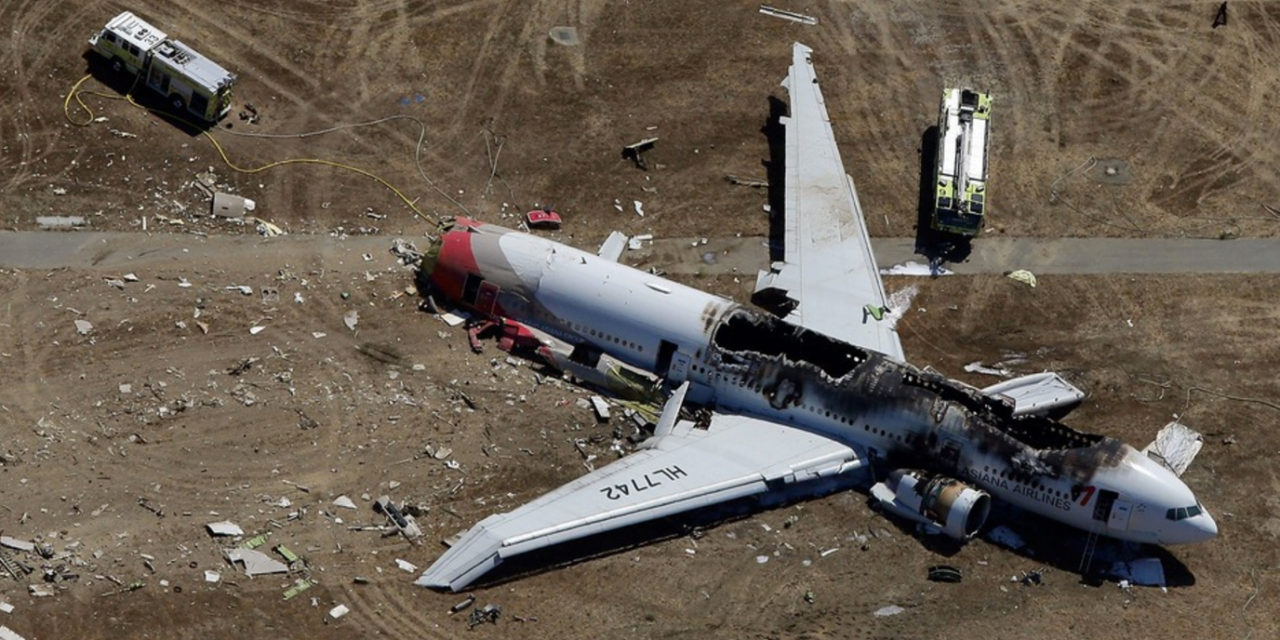Asiana Flight 214’s crash in San Francisco, on Saturday, took two lives and has left many forever changed, through spinal injuries that will rob some of the ability to walk, and through emotional scars that will take months, if not years, to heal.
Still, I’m thankful that so many made it alive. I will be taking a flight with my family on Thursday, and I know that the crash will be on my mind, as well as this post about my fear of flying, written in 2011. Two years after writing the post, I can say that I’ve mostly conquered my fear. “Mostly” is the key word.
It seems that Asiana’s crash was not due to birds nor terrorists, two main elements of my post. But that doesn’t provide any comfort. How I wish that we could go everywhere in trains.
—————————————–
I am a glass-is-half-full type of person. However, when it comes to flying, there are simply too many clouds and absolutely no silver lining. I’ve been trying really hard to get over what I know is an irrational fear. Statistics show that (1) flying is the safest form of travelling, (2) thousands of planes take off daily and (3) one is more likely to die in a car than in an airplane crash. Blah, blah, blah… I am not convinced.
It’s a bird…It’s a plane…It’s a crash
Recently I came across some disturbing information that augmented my already substantial fear. According to a recent study, airline accidents stemming from collisions with birds have soared in the past two years. In 2009, 150 airplanes flying above 500 feet suffered severe bird strikes. This represents a 40% increase compared with the average number of bird strikes from 2000 to 2008. This trend continued in 2010, with two of the most serious bird-plane incidents occurring above 6,000 feet. The first involved a flight into Salt Lake City. A white pelican crashed against the plane’s nose causing the plane’s instrument panel to shut down. In the second incident, an LA-bound plane sustained a 12-inch rip in its wing after colliding with a bird. Leading experts in the field are calling for measures to reduce this hazard which is likely due, in part, to an increasing large bird population.
Great. Now when I fly, I evidently should be on the lookout for the random bird encounter. I don’t need the extra pressure. Isn’t it enough that I have to sit through a whole presentation about cabin depressurization, oxygen masks and under-seat life jackets? The freakiest part of all of this is that these presentations are now filmed using super-calm, “fake smile” type flight attendants explaining what to do in case of an accident. All I’m thinking is, “I’m going to die, this plane is going to crash, and no oxygen mask or seat cushion life-jacket wannabe is going to save me.”
Turbulence & Terrorists
I wasn’t always this scared of flying. At first, I was merely afraid of taking off. Not being remotely acquainted with physics, I always wondered how something so heavy could lift up into the air and stay there. The noise of the wheels retracting back into the plane would make me wonder what would happen if something failed during take off. What if the plane needs to come back down quickly, while everything is pointing upward? How can this scenario possibly turn out well? Thankfully this part of the flight is usually over in 2-3 minutes, leaving the rest of the journey relatively carefree, if it weren’t for turbulence, of course.
Can anyone with even the slightest amount of survival instinct not be freaked out by turbulence? I read a self-help ‘flight fear reduction’ book that tried to reassure readers by teaching them to think of turbulence as the equivalent of a car driving on a pothole-filled road. Right, except that the car is touching the road, and the plane is, well, in the middle of nothing but air!
However, in this day and age, turbulence is not the worst thing I worry about in mid-flight. Nope, now I also ponder the possibility that some terrorist in an isolated field, over which the airplane is flying, is in possession of a ground-to-air missile launcher that could blow my plane out of the sky. I have no idea what distance ground-to-air missiles can cover, but leave this to the terrorists to figure out. They spend a big portion of their day thinking precisely about these types of problems. In the case that this proves too challenging for them, all they have to do is sneak explosives on board in their checked-in luggage. While we are virtually stripped searched with new x-ray vision scanners, are asked to take off our belts and shoes, to open up our carry-ons, to empty out our children’s water bottles, and to perform other humiliating or totally useless tasks, are we sure that 100% of checked-in luggage is being scanned with such rigor? I think not!
Hard Landing
At one point, landing was my favorite part of the flight. I used to love to land. It means getting back down to terra firma, where we belong. Then I spoke to my brother, who has taken flying lessons, and he explained that landing is even more dangerous than take-off. He wanted to explain why, but I didn’t want to hear it.
So as you can see my fear of flying is real and palpable. Did I need to add the bird factor into the mix? Did I need to find out that, apart from everything that makes me fearful about flying, now I have to worry about our feathered friends not being aware of a metal bird that is bigger, badder and noisier than they are? It’s too bad human cloning is not where it needs to be so that Chesley “Sully” Sullenberger, of Miracle-on-the-Hudson acclaim (New York Jet Crash Called “Miracle on the Hudson”), would be piloting as many airplanes as “human-cloningly” possible, not only to save us from the birds but to take away at least one of my flying fears.











